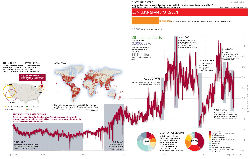 It’s a terrible nuisance. Nobody wants it. It doesn’t do us any good. So why do we receive so much SPAM?
It’s a terrible nuisance. Nobody wants it. It doesn’t do us any good. So why do we receive so much SPAM?
The bottom line is that for a relatively small expenditure, SPAMmers can make a lot of money. This chart, put together by NewScientist, not only gives an interesting (is that possible?) graphical history of spam, but it also monetizes spam. Click on the chart to see the enlarged view.
The math goes like this:
A sampling of one pharmaceutical spammer shows 35 million Spam messages in one month in 2008. The sampling represents only 1.5% of one botnet on one Spam server worldwide.
Of the 35M messages sent, only 8.2 million made it to real addresses. The others were sent to non-existant addresses or otherwise bounced.
10,500 people actually opened the messages and clicked on a link within the email. Of those, 28 of those people purchased something.
Extrapolated to all pharmaceutical Spam sent in 2008, the sales number becomes $3.5 million.
Not that this is a comfort to any of us, but it certainly explains why we receive so much SPAM.